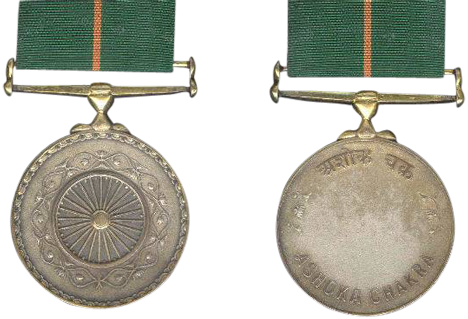|
Bhure Lal
Shri Bhurelal, AC (20 March 1938) was a police personnel who was awarded India's highest peacetime gallantry award Ashoka Chakra. Early life Shri Bhurelal was born on 20 March 1938 at Bajarangarh village of Guna district, Madhya Pradesh. His father's name was Sri Nanhulal. Police career Shri Bhurelal joined Madhya Pradesh Police on 20 June 1965. He served the police department for 7 years. Gallant act There was a reign of terror of a notorious dacoit Nahar Singh in the surrounding areas of Guna district of Madhya Pradesh. Nahar Singh used to give a tough time to the police. He used to loot villages. There was news that on the nights of 14 and 15 July, notorious dacoit Nahar Singh, with his group, was hiding in Gindkho forest. To check the truth behind this news, Sri Bhurelal himself decided to go to forest. This was a very dangerous step, but he went ahead and found out it to be true and Nahar Singh was hiding in that forest. Shri Bhurelal informed about this to his divi ... [...More Info...] [...Related Items...] OR: [Wikipedia] [Google] [Baidu] |
Shri
Shri (; , ) is a Sanskrit term denoting resplendence, wealth and prosperity, primarily used as an honorific. The word is widely used in South and Southeast Asian languages such as Marathi, Malay (including Indonesian and Malaysian), Javanese, Balinese, Sinhala, Thai, Tamil, Telugu, Hindi, Nepali, Malayalam, Kannada, Sanskrit, Pali, Khmer, and also among Philippine languages. It is usually transliterated as ''Sri'', ''Sree'', ''Shri'', Shiri, Shree, ''Si'', or ''Seri'' based on the local convention for transliteration. The term is used in Indian subcontinent and Southeast Asia as a polite form of address equivalent to the English "Mr." in written and spoken language, but also as a title of veneration for deities or as honorific title for local rulers. Shri is also another name for Lakshmi, the Hindu goddess of wealth, while a ''yantra'' or a mystical diagram popularly used to worship her is called Shri Yantra. Etymology Monier-Williams Dictionary gives the meaning of the ... [...More Info...] [...Related Items...] OR: [Wikipedia] [Google] [Baidu] |
Ashoka Chakra (military Decoration)
The Ashoka Chakra (alternative spelling: Ashok Chakra) is India's highest peacetime military decoration awarded for valor, courageous action, or self-sacrifice away from the battlefield. It is the peacetime equivalent of the Param Vir Chakra (PVC) and is awarded for the "most conspicuous bravery or some daring or pre-eminent valour or self-sacrifice" other than in the face of the enemy. The decoration may be awarded either to military or civilian personnel. Naik Narbahadur Thapa, Havildar Bachittar Singh and Flight Lieutenant Suhas Biswas were the first recipients of the Ashoka Chakra. Subsequent awards of the Ashoka Chakra are recognized by a bar to the medal ribbon. A recipient can be awarded the Kirti Chakra or Shaurya Chakra in addition to separate acts of gallantry. History The medal was originally established on 4 January 1952 as the "Ashoka Chakra, Class I" as the first step of a three-class sequence of non-combatant bravery decorations. In 1967, these decorations ... [...More Info...] [...Related Items...] OR: [Wikipedia] [Google] [Baidu] |
Madhya Pradesh
Madhya Pradesh (, ; meaning 'central province') is a state in central India. Its capital is Bhopal, and the largest city is Indore, with Jabalpur, Ujjain, Gwalior, Sagar, and Rewa being the other major cities. Madhya Pradesh is the second largest Indian state by area and the fifth largest state by population with over 72 million residents. It borders the states of Uttar Pradesh to the northeast, Chhattisgarh to the east, Maharashtra to the south, Gujarat to the west, and Rajasthan to the northwest. The area covered by the present-day Madhya Pradesh includes the area of the ancient Avanti Mahajanapada, whose capital Ujjain (also known as Avantika) arose as a major city during the second wave of Indian urbanisation in the sixth century BCE. Subsequently, the region was ruled by the major dynasties of India. The Maratha Empire dominated the majority of the 18th century. After the Anglo-Maratha Wars in the 19th century, the region was divided into several princel ... [...More Info...] [...Related Items...] OR: [Wikipedia] [Google] [Baidu] |
India
India, officially the Republic of India (Hindi: ), is a country in South Asia. It is the seventh-largest country by area, the second-most populous country, and the most populous democracy in the world. Bounded by the Indian Ocean on the south, the Arabian Sea on the southwest, and the Bay of Bengal on the southeast, it shares land borders with Pakistan to the west; China, Nepal, and Bhutan to the north; and Bangladesh and Myanmar to the east. In the Indian Ocean, India is in the vicinity of Sri Lanka and the Maldives; its Andaman and Nicobar Islands share a maritime border with Thailand, Myanmar, and Indonesia. Modern humans arrived on the Indian subcontinent from Africa no later than 55,000 years ago., "Y-Chromosome and Mt-DNA data support the colonization of South Asia by modern humans originating in Africa. ... Coalescence dates for most non-European populations average to between 73–55 ka.", "Modern human beings—''Homo sapiens''—originated in Africa. Then, int ... [...More Info...] [...Related Items...] OR: [Wikipedia] [Google] [Baidu] |


_male.jpg)